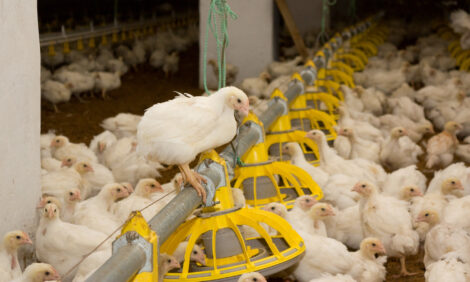



Global Chicken Meat to Set New Record; Turkey Output Flat
Total broiler meat output is forecast to be three per cent higher in 2012 than this year and set a new record, while turkey production will be little changed, according to the USDA Foreign Agricultural Service in its latest six-monthly Livestock and Poultry: World Markets and Trade report.BROILER MEAT: 2012 FORECAST OVERVIEW
Production
Global production is forecast up nearly three per cent to 83.1 million tons, driven by strong domestic demand in China and Brazil. However, growth will be slower than the previous two years given the rising cost of feed and a slow-down in US production.

Slight reductions for the United States and Mexico
The United States, the world’s largest broiler meat producer, is forecast to decline one per cent to 16.6 million tons, as lower broiler prices and relatively high costs constrain profitability. Relatively high production costs are also forecast to adversely impact Mexico’s production, down one per cent to 2.9 million tons.
Brazil and China propel world expansion
Brazil and China are both forecast up five per cent to 13.6 and 13.8 million tons, respectively. Both are driven by stronger domestic demand, greater disposable income, economic growth, an expanding middle class and competitive prices that favour poultry over red meats. Brazil is also benefiting from more stable production costs due to ample feed supplies.
In China, expansion is supported by lower rates of reported disease and improving economies of scale through continuing vertical integration. Rising broiler meat prices will be more than offset by relatively high feed costs. A larger inventory of grand parent generation (GPG) breeding broilers is paving the way for expanded and more efficient commercial production.
Russian support leads to greater output
Subsidised feed costs, import restrictions and continued investment are forecast to drive Russia production nine per cent higher to 2.8 million tons. Continuing reductions in tariff rates quota (TRQ) volumes will limit imports and therefore support elevated prices for domestic producers.
Increased global demand boosts output by minor suppliers
Robust profitability, strong investment and rising domestic and foreign demand has stimulated production in Argentina, Thailand, Turkey and Ukraine.
Trade
Global exports are forecast five per cent stronger to a record of 9.6 million tons with greater demand from emerging markets, most notably the Middle East, Southeast Asia and Sub Saharan Africa.
US exports are forecast to rebound two per cent to 3.0 million tons as growth is expected in the Mexican and Asian markets (especially South Korea and Hong Kong). Mounting demand from emerging markets particularly in Sub Saharan Africa will continue to support expanded shipments. However, exports to Russia are constrained and are likely to decline due to the lower TRQ quantity.
Brazil remains the leading exporter, climbing five per cent to 3.5 million tons. The Middle East will be the primary driver for export expansion, fuelled by anticipated economic growth and a rising population. Brazil is able to ship significant quantities of whole birds as well as halal product. The largest poultry processor and exporter (Brasil Foods) is constructing a processing plant in the UAE, which is expected to generate demand for imports. Shipments to Venezuela are expected to expand, despite commercial challenges.
The EU is forecast at 1.1 million tons, up two per cent. Additional expansion of exports is limited by high feed costs, escalating competition and fading shipments to Russia due to a lower TRQ volume.
China and Thailand continue to be constrained by disease-related restrictions, and thus are limited to shipping prepared/preserved products. Key destinations for China are likely to remain Japan, Hong Kong and Malaysia. In addition to Asian markets, Thailand will continue to benefit from its access to the EU. China and Thailand are expected grow nine per cent to 445,000 and 500,000 tons, respectively.
Turkey gains 27 per cent to 193,000 tons, primarily on Middle East demand – Iraq and Iran – as domestic production continues to grow, generating more exportable supplies.
TURKEY MEAT: 2012 FORECAST OVERVIEW
Production
World production is virtually unchanged at 5.3 million tons. Brazil production is forecast up five per cent, and offset by lower production in the EU and US, forecast down two per cent and one per cent, respectively.
Trade
Lacklustre import demand will keep world trade flat. EU, Brazil and Canada exports are forecast to remain relatively stable. A five per cent drop for US exports is forecast based largely on soft demand from several markets. China imports are forecast higher as elevated domestic prices for pork and broiler meat make turkey meat a price-competitive alternative.
Further Reading
| - | You can view the full report by clicking here. |
October 2011









